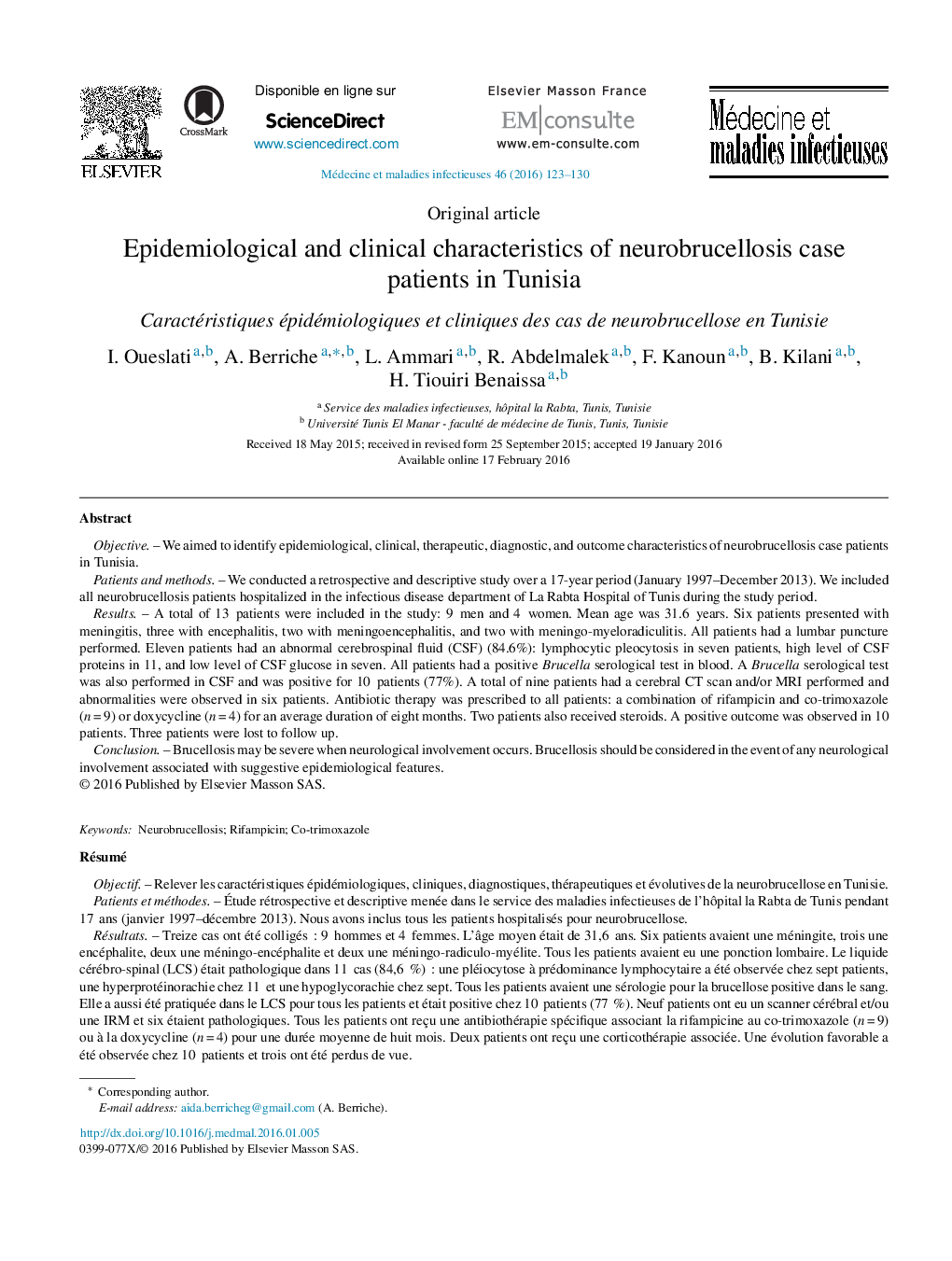| کد مقاله | کد نشریه | سال انتشار | مقاله انگلیسی | نسخه تمام متن |
|---|---|---|---|---|
| 3412257 | 1224218 | 2016 | 8 صفحه PDF | دانلود رایگان |
ObjectiveWe aimed to identify epidemiological, clinical, therapeutic, diagnostic, and outcome characteristics of neurobrucellosis case patients in Tunisia.Patients and methodsWe conducted a retrospective and descriptive study over a 17-year period (January 1997–December 2013). We included all neurobrucellosis patients hospitalized in the infectious disease department of La Rabta Hospital of Tunis during the study period.ResultsA total of 13 patients were included in the study: 9 men and 4 women. Mean age was 31.6 years. Six patients presented with meningitis, three with encephalitis, two with meningoencephalitis, and two with meningo-myeloradiculitis. All patients had a lumbar puncture performed. Eleven patients had an abnormal cerebrospinal fluid (CSF) (84.6%): lymphocytic pleocytosis in seven patients, high level of CSF proteins in 11, and low level of CSF glucose in seven. All patients had a positive Brucella serological test in blood. A Brucella serological test was also performed in CSF and was positive for 10 patients (77%). A total of nine patients had a cerebral CT scan and/or MRI performed and abnormalities were observed in six patients. Antibiotic therapy was prescribed to all patients: a combination of rifampicin and co-trimoxazole (n = 9) or doxycycline (n = 4) for an average duration of eight months. Two patients also received steroids. A positive outcome was observed in 10 patients. Three patients were lost to follow up.ConclusionBrucellosis may be severe when neurological involvement occurs. Brucellosis should be considered in the event of any neurological involvement associated with suggestive epidemiological features.
RésuméObjectifRelever les caractéristiques épidémiologiques, cliniques, diagnostiques, thérapeutiques et évolutives de la neurobrucellose en Tunisie.Patients et méthodesÉtude rétrospective et descriptive menée dans le service des maladies infectieuses de l’hôpital la Rabta de Tunis pendant 17 ans (janvier 1997–décembre 2013). Nous avons inclus tous les patients hospitalisés pour neurobrucellose.RésultatsTreize cas ont été colligés : 9 hommes et 4 femmes. L’âge moyen était de 31,6 ans. Six patients avaient une méningite, trois une encéphalite, deux une méningo-encéphalite et deux une méningo-radiculo-myélite. Tous les patients avaient eu une ponction lombaire. Le liquide cérébro-spinal (LCS) était pathologique dans 11 cas (84,6 %) : une pléiocytose à prédominance lymphocytaire a été observée chez sept patients, une hyperprotéinorachie chez 11 et une hypoglycorachie chez sept. Tous les patients avaient une sérologie pour la brucellose positive dans le sang. Elle a aussi été pratiquée dans le LCS pour tous les patients et était positive chez 10 patients (77 %). Neuf patients ont eu un scanner cérébral et/ou une IRM et six étaient pathologiques. Tous les patients ont reçu une antibiothérapie spécifique associant la rifampicine au co-trimoxazole (n = 9) ou à la doxycycline (n = 4) pour une durée moyenne de huit mois. Deux patients ont reçu une corticothérapie associée. Une évolution favorable a été observée chez 10 patients et trois ont été perdus de vue.ConclusionLa brucellose peut être grave en cas de focalisation, en l’occurrence neurologique, et doit être évoquée devant tout tableau neurologique associé à un contexte épidémiologique évocateur.
Journal: Médecine et Maladies Infectieuses - Volume 46, Issue 3, May 2016, Pages 123–130
